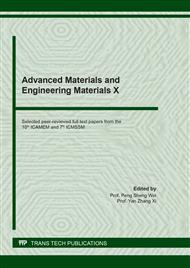[1]
A. Sáez-de-Guinoa Vilaplana, V. J. Ferreira, A. M. López-Sabirón, A. Aranda-Usón, C. Lausín-González, C. Berganza-Conde, and G. Ferreira, Utilization of Ladle Furnace slag from a steelwork for laboratory scale production of Portland cement,, Construction and Building Materials, vol. 94, pp.837-843, 2015/09/30/, (2015).
DOI: 10.1016/j.conbuildmat.2015.07.075
Google Scholar
[2]
P. K. Mehta, Greening of the concrete industry for sustainable development,, Concrete international, vol. 24, no. 7, pp.23-28, (2002).
Google Scholar
[3]
L. K. Turner, and F. G. Collins, Carbon dioxide equivalent (CO2-e) emissions: A comparison between geopolymer and OPC cement concrete,, Construction and building materials, vol. 43, pp.125-130, (2013).
DOI: 10.1016/j.conbuildmat.2013.01.023
Google Scholar
[4]
J. Xie, J. Wang, B. Zhang, C. Fang, and L. Li, Physicochemical properties of alkali activated GGBS and fly ash geopolymeric recycled concrete,, Construction and Building Materials, vol. 204, pp.384-398, (2019).
DOI: 10.1016/j.conbuildmat.2019.01.191
Google Scholar
[5]
A. Mohan, and M. T. Hayat, Characterization of mechanical properties by preferential supplant of cement with GGBS and silica fume in concrete,, Materials Today: Proceedings, vol. 43, pp.1179-1189, (2021).
DOI: 10.1016/j.matpr.2020.08.733
Google Scholar
[6]
L. Jiang, C. Li, C. Wang, N. Xu, and H. Chu, Utilization of flue gas desulfurization gypsum as an activation agent for high-volume slag concrete,, Journal of Cleaner Production, vol. 205, pp.589-598, (2018).
DOI: 10.1016/j.jclepro.2018.09.145
Google Scholar
[7]
V. H. Dodson, Pozzolans and the pozzolanic reaction,, Concrete admixtures, pp.159-201: Springer, (1990).
DOI: 10.1007/978-1-4757-4843-7_7
Google Scholar
[8]
A. Kampala, and S. Horpibulsuk, Engineering properties of calcium carbide residue stabilized silty clay,, J. Mater. Civ. Eng, vol. 10, no. 1061, pp.632-644, (2013).
DOI: 10.1061/(asce)mt.1943-5533.0000618
Google Scholar
[9]
P. Khongpermgoson, A. Abdulmatin, W. Tangchirapat, and C. Jaturapitakkul, Evaluation of compressive strength and resistance of chloride ingress of concrete using a novel binder from ground coal bottom ash and ground calcium carbide residue,, Construction and Building Materials, vol. 214, pp.631-640, (2019).
DOI: 10.1016/j.conbuildmat.2019.04.145
Google Scholar
[10]
Y. Liu, C.-W. Chang, A. Namdar, Y. She, C.-H. Lin, X. Yuan, and Q. Yang, Stabilization of expansive soil using cementing material from rice husk ash and calcium carbide residue,, Construction and Building Materials, vol. 221, pp.1-11, (2019).
DOI: 10.1016/j.conbuildmat.2019.05.157
Google Scholar
[11]
ASTM C150 / C150M-20, Standard Specification for Portland Cement, ASTM International, West Conshohocken, PA, (2020).
Google Scholar
[12]
ASTM C618-19, Standard Specification for Coal Fly Ash and Raw or Calcined Natural Pozzolan for Use in Concrete, ASTM International, West Conshohocken, PA, (2019).
DOI: 10.1520/c0618-00
Google Scholar
[13]
ASTM C109 / C109M-20b, Standard Test Method for Compressive Strength of Hydraulic Cement Mortars (Using 2-in. or [50 mm] Cube Specimens), ASTM International, West Conshohocken, PA, (1999).
DOI: 10.1520/c0109_c0109m-20
Google Scholar
[14]
ASTM C305-20, Standard Practice for Mechanical Mixing of Hydraulic Cement Pastes and Mortars of Plastic Consistency, ASTM International, West Conshohocken, PA, (2020).
DOI: 10.1520/c0305-13
Google Scholar


